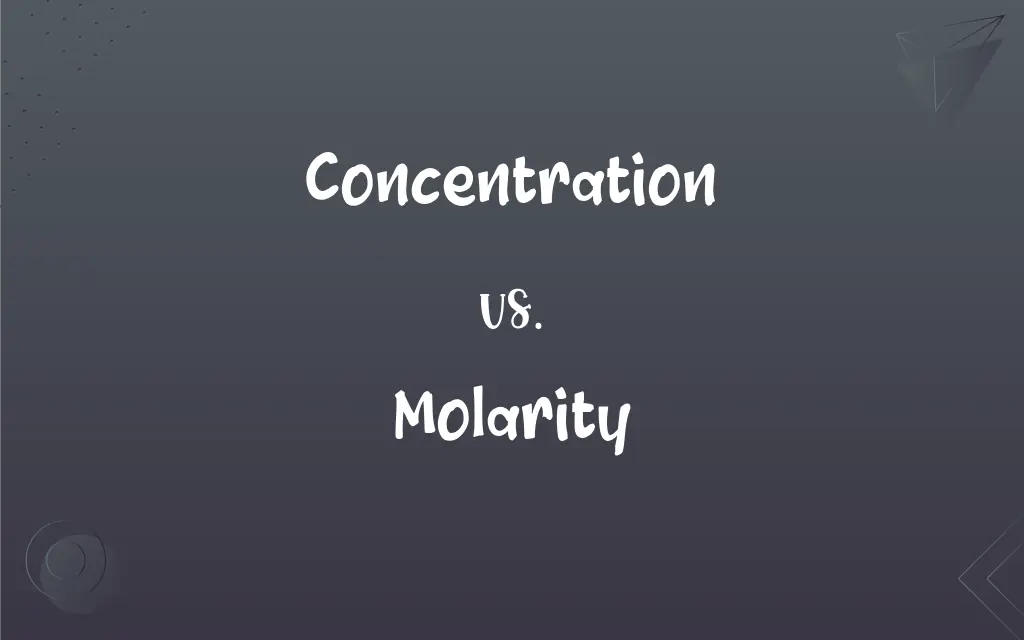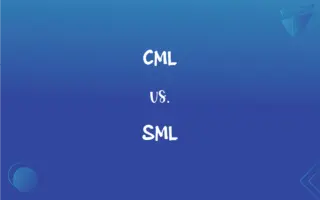Concentration vs. Molarity: What's the Difference?
Edited by Aimie Carlson || By Janet White || Published on February 21, 2024
Concentration refers to the amount of a substance in a given volume, while molarity is a specific unit of concentration, measuring moles of a substance per liter of solution.

Key Differences
Concentration is a general term in chemistry that describes the amount of a substance present in a certain volume of solution. It can be expressed in various units such as mass per volume, percentage, or molarity. Molarity, specifically, is a measure of concentration that expresses the number of moles of a solute per liter of solution.
Concentration gives a broad understanding of how much of a given substance is present in a solution and can be adapted to different measurement units depending on the context. Molarity is a more specific term and is particularly useful in stoichiometric calculations in chemistry, as it directly relates to the number of molecules or ions in a solution.
Concentration can vary in its expression; for instance, it can be conveyed as mass percent, volume percent, mole fraction, or molarity. Molarity is a precise unit, designated as moles per liter (M), and is used exclusively to express the concentration of a solute in a solution.
Concentration is a fundamental concept in various fields like chemistry, biology, and environmental science, indicating how dense a solution is with a particular substance. Molarity, being a standard unit for concentration in chemistry, is essential for reactions and calculations involving solutions.
In practice, when a scientist talks about concentration, they could be referring to any measurement that reflects the quantity of a substance in a solution. When they use molarity, they specifically mean the moles of solute per liter of solution, which is critical for precise chemical reactions and calculations.
ADVERTISEMENT
Comparison Chart
Definition
Amount of substance in a given volume of solution
Moles of substance per liter of solution
Units
Various (e.g., mg/mL, %, ppm)
Moles per liter (M)
Use
General term in many fields
Specific to stoichiometry in chemistry
Expression
Can be in terms of mass, volume, or moles
Exclusively in terms of moles per volume
Application
Broad in science
Specific in chemical solution preparation and reactions
ADVERTISEMENT
Concentration and Molarity Definitions
Concentration
Concentration is also measured as a percentage, like weight percent or volume percent.
The bleach solution has a concentration of 5% sodium hypochlorite.
Molarity
Molarity is the number of moles of a solute per liter of solution.
The molarity of the NaCl solution was 1 M.
Concentration
It can be expressed as mass per volume, such as milligrams per milliliter.
The drug's concentration was 250 mg/mL in the medicinal syrup.
Molarity
It's a standard unit of concentration in chemistry.
To prepare a 0.5 M HCl solution, specific moles of HCl were dissolved in water.
Concentration
It can be expressed as parts per million (ppm) for very dilute solutions.
The concentration of pollutants in the water was measured at 2 ppm.
Molarity
Molarity is crucial for stoichiometric calculations in reactions.
The reaction required a 0.1 M solution of silver nitrate.
Concentration
Concentration is a key factor in solution preparation and analysis in various scientific fields.
Adjusting the concentration of reactants changed the rate of the chemical reaction.
Molarity
Molarity allows for precise measurements in preparing chemical solutions.
For the experiment, a 0.05 M potassium permanganate solution was necessary.
Concentration
Concentration is the amount of a substance in a given volume.
The concentration of salt in the solution was 3 grams per liter.
Molarity
It's represented by the symbol 'M'.
A 2 M sulfuric acid solution was used in the titration.
Concentration
The act or process of concentrating, especially the fixing of close, undivided attention.
Molarity
Abbr. M The concentration of a solution expressed in moles of solute per liter of solution.
Concentration
The condition of being concentrated.
Molarity
(chemistry) the concentration of a substance in solution, expressed as the number of moles of solute per litre of solution
Molarity
Concentration measured by the number of moles of solute per liter of solvent
FAQs
What does molarity measure?
Molarity measures the number of moles of a solute per liter of solution.
How is concentration expressed?
Concentration can be expressed in various units like mg/mL, %, ppm, or molarity.
Can concentration be a percentage?
Yes, concentration can be expressed as a percentage, such as weight or volume percent.
Why is molarity important in chemistry?
Molarity is important for accurate stoichiometric calculations in chemical reactions.
What is concentration in chemistry?
Concentration is the amount of a substance present in a specific volume of solution.
Is concentration always the same as molarity?
No, concentration is a broader term, while molarity is a specific way to express concentration.
How do you calculate molarity?
Molarity is calculated by dividing the moles of solute by the volume of solution in liters.
What is a common use of concentration in science?
Concentration is commonly used in preparing solutions and analyzing substances in various scientific fields.
What is the symbol for molarity?
The symbol for molarity is 'M'.
How do you increase concentration?
Concentration can be increased by adding more solute or reducing the volume of the solvent.
How does molarity relate to moles?
Molarity directly relates to the number of moles of solute in a given volume of solution.
Does temperature affect molarity?
Molarity is not directly affected by temperature, though volume changes due to temperature can affect it.
Can concentration be used in environmental science?
Yes, concentration is used in environmental science to measure pollutants in air and water.
What's the difference between molarity and molality?
Molarity is moles per liter of solution, while molality is moles per kilogram of solvent.
Is a higher molarity more concentrated?
Yes, a higher molarity indicates a more concentrated solution.
How do you convert concentration to molarity?
If concentration is given in another unit, it can be converted to molarity with appropriate conversions based on the solute and solvent.
Can concentration refer to gases?
Yes, concentration can refer to the amount of a gas in a given volume, like ppm or ppb.
Is molarity used in biology?
Yes, molarity is used in biology, particularly in molecular biology for preparing solutions.
What does a 1 M solution mean?
A 1 M solution means there is one mole of solute per liter of solution.
Why is molarity preferred in chemical reactions?
Molarity is preferred because it directly relates to the number of reacting particles in a solution, which is crucial for reaction stoichiometry.
About Author
Written by
Janet WhiteJanet White has been an esteemed writer and blogger for Difference Wiki. Holding a Master's degree in Science and Medical Journalism from the prestigious Boston University, she has consistently demonstrated her expertise and passion for her field. When she's not immersed in her work, Janet relishes her time exercising, delving into a good book, and cherishing moments with friends and family.
Edited by
Aimie CarlsonAimie Carlson, holding a master's degree in English literature, is a fervent English language enthusiast. She lends her writing talents to Difference Wiki, a prominent website that specializes in comparisons, offering readers insightful analyses that both captivate and inform.






























































